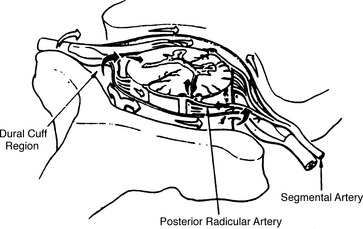CHAPTER 41 INTRASPINAL OPIOIDS
7. Which specific properties of the opioid molecule play a role in reaching the dorsal horn?
Several pharmacokinetic properties determine the degree to which intraspinal opioids reach the dorsal horn: lipid solubility, molecular weight and shape, surface area exposed (i.e., “spread”) (Fig. 41-1), and route of administration (epidural vs. subarachnoid). The most important of these appears to be molecular weight.
8. Are all opioids created equal?
No. The most useful property for classifying intraspinal opioids is lipid solubility. Opioids can be divided into two classes: lipophilic (lipid-soluble) versus hydrophilic (lipid-insoluble). Examples of lipophilic opioids include fentanyl, sufentanil, and meperidine. Morphine and hydromorphone are hydrophilic. The octanol water coefficient is the standard for grading and comparing lipophilicity (Table 41-1).
TABLE 41-1. Relative Octanol: Water Coefficients (Compared to Morphine)
| Opioid | O:W |
|---|---|
| Morphine | 1 |
| Hydromorphone | 4 |
| Meperidine | 40 |
| Fentanyl | 400 |
| Sufentanil | 1600 |
Stay updated, free articles. Join our Telegram channel

Full access? Get Clinical Tree




